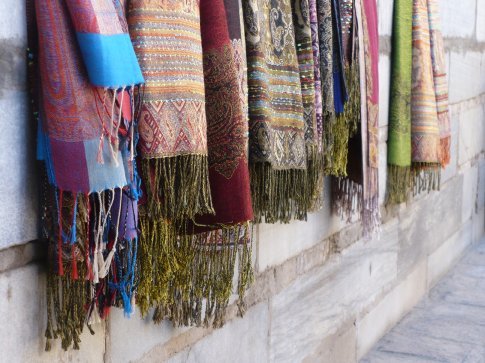March 23: Bukhara to UrgenchWe caught a ride out to Urgench, the capital of the Khorezm province, with a friend of a friend heading the same way. Western Uzbekistan is in stark contrast to the eastern urban centers, with the landscape dominated by expansive deserts less than an hour outside of Bukhara. On the way, we stopped for a lunch of cotton oil-fried fish from the nearby Amu Darya; usually I hate the taste and smell of fish, but this one was so deeply fried that it was actually not bad, particularly when chased with a semi-spicy tomato mix. In Urgench, we stayed with the family of another friend of a friend, which included two English-speaking sons my age who I was particularly happy to have the company of on the tennis court and football pitch (alleyways)!

March 24: Khiva
We spent most of the day in gorgeous Khiva, which is essentially an open-air museum-city chock full of the 4Ms (mosques, medrassas, minarets, and mausoleums). The inside of the ancient city is known as Ichan Qala and is surrounded by a 2.2 km perimeter of 12-m high walls. There are four gates facing each direction, with the main gates known as Ota Darvoza (‘father’s gates’; in Islamic culture, the father is a strong figure of leadership and strength). The iconic Kaita Minaret looks like a curiously short and fat version of all the other minarets I had seen to date; indeed, it was supposed to be an immense 120 m tall – ‘the biggest in the land’ – and the Khan at the time secretly planned the execute the architect upon its completion so that no one else would know how to build such a high tower. However, the architect’s students learned of this plan and cleverly wrote warnings on bricks to their master, who subsequently fled and left the minaret unfinished.

More gruesome tales were told of the Royal/Central Square next to the Khan’s palace, which doubled as the stage for more public executions of a particularly torturous nature. Criminals spent 5 days in the Royal Prison (I’m sure it contained no luxuries fit for a king) and then were executed depending on their deed: those who tried to sleep with women of the royal harem were buried alive upside down; those of an undesirable (i.e. Turkmen, at that time) ethnic background were thrown off the minaret; female adulterers were held in a bag filled with wild cats, which were beaten with clubs to maul the woman to death; male adulterers were impaled on a stake. One particularly brutal method involved a man stoning his own daughter to death after she tried to escape with her lover instead of marrying an older man he had arranged; she had to watch her lover be hanged first, though. The painting in the prison depicting this one also shows the father with no hat, which is a symbol of shame for the father and indicates to everyone else that a family member has failed him. Not surprisingly, Khiva boasted the ‘lowest crime rate in the world’.
One of the more interesting mausoleums was that of Pahlavan Mahmoud, one of Khiva’s celebrated heroes. He lived in the 14th century and was a famous Sufi poet and writer and, curiously, an ‘invincible wrestler’ (according to the humourously translated sign at the mausoleum). He allegedly only lost one fight in his entire wrestling career, and it was one of mercy: before the match, an old woman approached him and told him that her son would be murdered if Pahlavan emerged victorious, so he willingly lost to save the man’s life.

Among the many 4 Ms were small silk and carpet-weaving workshops, some sponsored by UNESCO, which we were able to watch for free (most ‘side attractions’ like special mausoleums or mini museums have an extra cost).
One of my personal favourite sights was the Juma Mosque, built in the 10th century and filled with 213 wooden columns, each with its own unique design. Informed by the then-increasingly popular algebraic and geometric theories of Al-Khorezm (the father of the Latinized ‘algorithm’), the columns are positioned in a precise configuration and distance from each other so that every worshipper in the mosque would be able to see the imam during namaz. The overall effect is one of being in a sort of holy indoor forest, complete with beams of sunlight dancing across the dusty ground…

Tomorrow, we’ll be visiting a dusty ground of another, particularly bleaker nature – the remains of the Aral Sea.